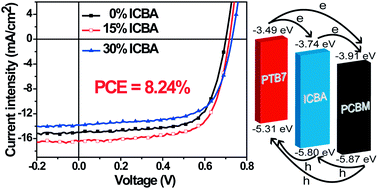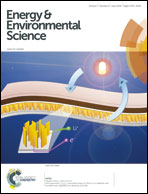Efficient ternary blend polymer solar cells with indene-C60 bisadduct as an electron-cascade acceptor
Abstract
Indene-C60 bisadduct (ICBA) is used as an electron-cascade acceptor material in poly{4,8-bis[(2-ethylhexyl)oxy]benzo[1,2-b:4,5-b′]dithiophene-2,6-diyl-alt-3-fluoro-2-[(2-ethylhexyl)carbonyl]thieno[3,4-b]thiophene-4,6-diyl} (PTB7):[6,6]-phenyl-C71-butyric-acid-methyl-ester (PC71BM) blend to fabricate ternary blend polymer solar cells (PSCs). Due to higher lowest unoccupied molecular orbital (LUMO) energy levels of ICBA relative to PC71BM, the open circuit voltage (VOC) increases with the addition of ICBA. ICBA plays a bridging role between PTB7 and PC71BM, thus providing more routes for charge transfer at the donor/acceptor (D/A) interface. When the ICBA content is much smaller than the PC71BM content, the morphology of the ternary blend active layer is similar to that of the PTB7:PC71BM blend, which guarantees suitable phase separation and efficient charge transport. Ternary blend devices with 15% ICBA content exhibit an average power conversion efficiency (PCE) of 8.13%, higher than that (7.23%) of the PTB7:PC71BM binary blend. Without any further device work (such as interlayer, invert structure and tandem cells), the ternary blend PSCs exhibit PCEs as high as 8.24%, which is the highest reported for ternary blend PSCs and ICBA-related PSCs.


 Please wait while we load your content...
Please wait while we load your content...